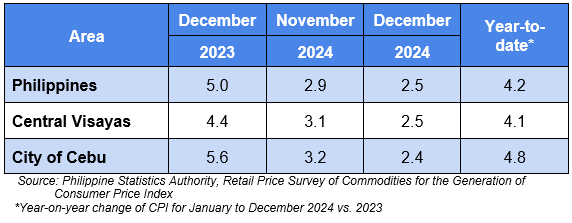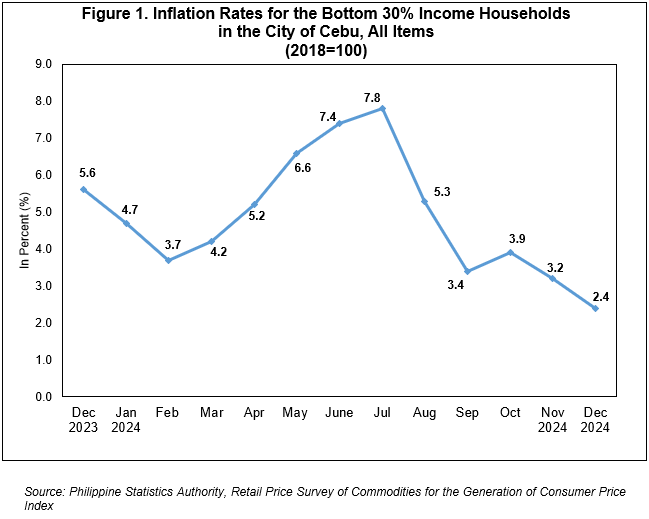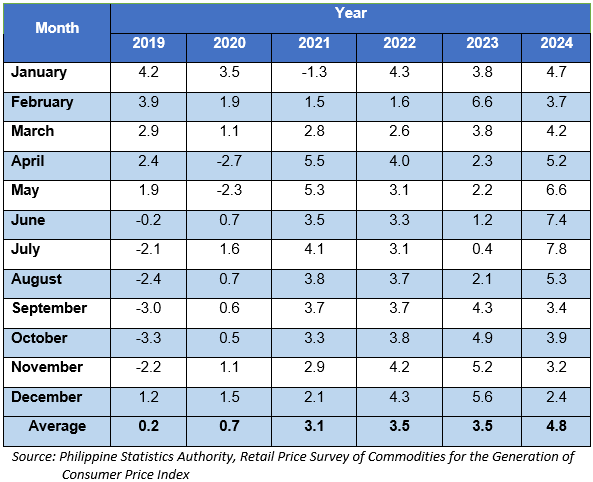Table A. Year-on-Year Inflation Rates
for the Bottom 30% Income Households, All Items
In Percent
(2018=100)


A. The Philippines
The country’s inflation rate for the bottom 30% income households slowed down to 2.5 percent in December 2024 from 2.9 percent in November 2024. This brings the average inflation from January to December 2024 for this income group to 4.2 percent. In December 2023, the inflation rate was posted at 5.0 percent. (Table A)
B. Central Visayas
1. Regional Inflation
Following the trend at the national level, inflation rate for the bottom 30% income households in Central Visayas slowed down to 2.5 percent in December 2024 from 3.1 percent in November 2024. The average inflation rate for the region from January to December 2024 was recorded at 4.1 percent. In December 2023, inflation rate in the region was higher which posted at 4.4 percent. (Table A)
C. City of Cebu
1. Headline Inflation
The headline inflation rate for the bottom 30% income households in the City of Cebu had a slower increase of 2.4 percent in December 2024 from 3.2 percent in November 2024. The city’s average inflation from January to December 2024 was 4.8 percent. In December 2023, the inflation rate stood at 5.6 percent. (Table A and Figure 1)
1.1 Main Drivers to the Downward Trend of Headline Inflation in the City of Cebu
The main source to the downward trend of the headline inflation rate for this income group in December 2024 was the slower year-on-year increase of food and non-alcoholic beverages at 1.2 percent from 3.6 percent in the previous month. (Table 4)
In contrast, faster annual increments were recorded in the following commodity group during the month:
a. Alcoholic beverage and tobacco, 0.4 percent from 0.3 percent;
b. Housing, water, electricity, gas and other fuels, 6.5 percent from 5.7 percent;
c. Furnishings, household equipment and routine household maintenance, 1.8 percent from 1.7 percent;
d. Health, 1.5 percent from 1.4 percent;
e. Recreation, sport and culture, 1.4 percent from 1.3 percent; and
f. Personal care, and miscellaneous goods and services, 3.5 percent from 3.4 percent. (Table 3)
Transport posted a slower annual decrease of 0.2 percent in December 2024 from 0.8 percent annual decline in November 2024. (Table 3)
Moreover, the indices of commodity groups that retained their previous month’s inflation were as follows:
a. Clothing and footwear, 1.6 percent;
b. Education services, 3.1 percent; and
c. Restaurants and accommodation services, 2.1 percent. (Table 3)
Meanwhile, the indices with no price movement were information and communication, and financial services. (Table 3)
1.2 Main Contributors to the Headline Inflation
The following commodity groups were the top three contributors to the December 2024 overall inflation for the bottom 30% income households in the City of Cebu:
a. Housing, water, electricity, gas and other fuels with 54.8 percent share or 1.3 percentage point;
b. Food and non-alcoholic beverages with 23.1 percent share or 0.6 percentage points; and
c. Restaurants and accommodation services with 12.1 percent share or 0.3 percentage point.
2. Food Inflation
Food inflation rate for the bottom 30% income households in the City of Cebu had a slower annual increase at 1.2 percent in December 2024 from 3.9 percent in November 2024. In December 2023, the food inflation stood at 9.8 percent. (Table 7)
2.1 Main Drivers to the Downtrend of Food Inflation
The downtrend in the food inflation during the month was primarily driven by the slower year-on-year increases of corn at 27.8 percent and fish and other seafood at 0.3 percent from their respective inflation rates at 61.1 percent and 1.8 percent in November 2024. Also contributed in the deceleration of food inflation were the faster annual decreases of rice at 3.0 percent and vegetables, tubers, plantains, cooking bananas and pulses at 2.5 percent from their respective annual increases of 0.4 percent and 18.7 percent in November 2024. (Table 5)
In addition, faster annual decreases were posted in the indices of milk, other dairy products and eggs at 0.1 percent from 1.6 percent annual increase and sugar, confectionary and desserts at 3.4 percent from 2.0 percent annual drop in November 2024. (Table 5)
In contrast, faster annual increments were recorded in the following commodity food groups in December 2024:
a. Flour, bread and other bakery products, pasta products, and other cereals, 0.8 percent from 0.7 percent;
b. Meat and other parts of slaughtered land animals, 6.4 percent from 3.0 percent;
c. Fruits and nuts, 7.7 percent from 1.5 percent;
d. Ready-made food and other food products not elsewhere classified, 4.4 percent from 4.3 percent. (Table 5)
Meanwhile, oils and fats index retained its previous month’s inflation rate at 2.3 percent annual decline. (Table 5)
2.2 Main Contributors to the Food Inflation
Food inflation contributed 20.9 percent share or 0.5 percentage point to the December 2024 overall inflation for this particular income group.
Among the food groups, the main contributors to the food inflation during the month were the following:
a. Meat and other parts of slaughtered land animals with 92.2 percent share or 1.1 percentage point;
b. Fruits and nuts with 21.8 percent share or 0.3 percentage point; and
c. Ready-made food and other food products not elsewhere classified with 14.1 percent share or 0.2 percentage point.
Table B. Year-on-Year Inflation Rates for the Bottom 30% Income Households in the City of Cebu, All Items
In Percent
January 2019 – December 2024
(2018=100)

Approved by:
MELCHOR B. BAUTISTA
Chief Statistical Specialist
KST/MJG

